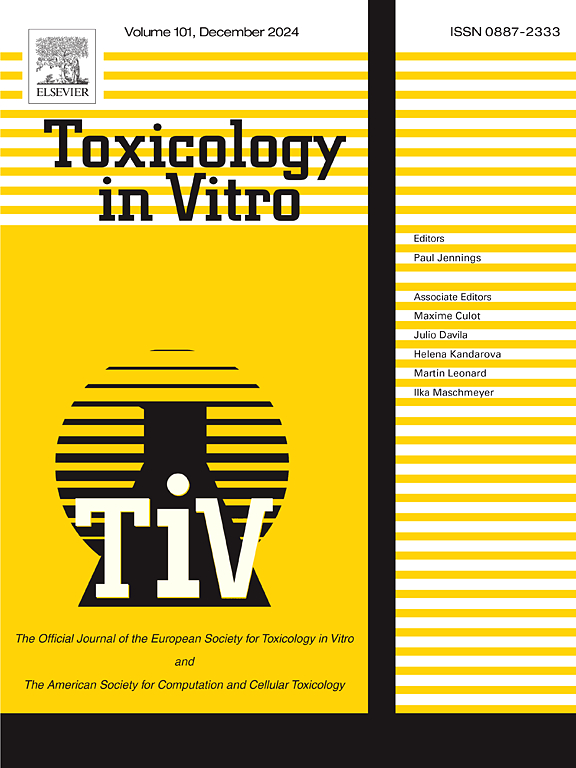A549 cells exposed to a marijuana smoke extract affect mono-layer integrity related to oxidative stress state
IF 2.6
3区 医学
Q3 TOXICOLOGY
引用次数: 0
Abstract
Marijuana smoke contains several toxic compounds that may induce dysregulation of oxidative mechanisms and barrier system in airway alveolar cells. This study aimed to assess whether marijuana smoke extract (MSE) modifies mono-layer integrity and antioxidant effects on the alveolar epithelial cells. A549 cells were exposed to MSE (0.1 to 5 μg/mL) or cannabinoid (+)-WIN 55,212–2 (WIN; 0.01 to 1 μM) for 24 h. Epithelial integrity and protein expression of claudin (Cl)-2, Cl-5, and occludin (Ocl) were evaluated by transepithelial electrical resistance (TEER), permeability assay, Western blot, immunofluorescence, and qPCR. TEER decreased after MSE or WIN exposure, whereas the monolayer permeability increased. Protein expression and localization of Cl-2 and Ocl were reduced after MSE treatment. However, WIN increased Cl-2 protein and decreased Cl-5 and Ocl. Differential gene expressions were observed between treatments. Malondialdehyde (MDA) production and advanced oxidation protein products (AOPP) determination showed that MSE increased AOPP, whereas WIN augmented the MDA production and decreased AOPP levels. The activity of antioxidant enzymes shows an increase in catalase, glutathione-S-transferase, γ-glutamyl transferase and arginase after MSE treatment and a decrease with WIN. Data indicates that MSE exposure alters epithelial integrity and the alveolar cells antioxidant response that, finally, may lead to lung damage.
暴露于大麻烟雾提取物的A549细胞影响与氧化应激状态相关的单层完整性
大麻烟雾中含有几种有毒化合物,可诱导气道肺泡细胞氧化机制和屏障系统失调。本研究旨在评估大麻烟提取物(MSE)是否改变肺泡上皮细胞的单层完整性和抗氧化作用。A549细胞暴露于MSE (0.1 ~ 5 μg/mL)或大麻素(+)-WIN 55,212-2 (WIN;通过上皮电阻值(TEER)、通透性测定、Western blot、免疫荧光和qPCR等方法评价claudin (Cl)-2、Cl-5和occludin (Ocl)的表达及上皮完整性。MSE或WIN暴露后,TEER降低,而单层通透性增加。MSE处理后,cl2和Ocl的蛋白表达和定位降低。而WIN增加了Cl-2蛋白,降低了Cl-5和Ocl。不同处理间观察到基因表达差异。丙二醛(MDA)生成和高级氧化蛋白产物(AOPP)测定表明,MSE增加了AOPP,而WIN增加了MDA生成并降低了AOPP水平。过氧化氢酶、谷胱甘肽- s -转移酶、γ-谷氨酰转移酶和精氨酸酶的抗氧化酶活性在MSE处理后升高,随WIN处理而降低。数据表明,MSE暴露会改变上皮完整性和肺泡细胞的抗氧化反应,最终可能导致肺损伤。
本文章由计算机程序翻译,如有差异,请以英文原文为准。
求助全文
约1分钟内获得全文
求助全文
来源期刊

Toxicology in Vitro
医学-毒理学
CiteScore
6.50
自引率
3.10%
发文量
181
审稿时长
65 days
期刊介绍:
Toxicology in Vitro publishes original research papers and reviews on the application and use of in vitro systems for assessing or predicting the toxic effects of chemicals and elucidating their mechanisms of action. These in vitro techniques include utilizing cell or tissue cultures, isolated cells, tissue slices, subcellular fractions, transgenic cell cultures, and cells from transgenic organisms, as well as in silico modelling. The Journal will focus on investigations that involve the development and validation of new in vitro methods, e.g. for prediction of toxic effects based on traditional and in silico modelling; on the use of methods in high-throughput toxicology and pharmacology; elucidation of mechanisms of toxic action; the application of genomics, transcriptomics and proteomics in toxicology, as well as on comparative studies that characterise the relationship between in vitro and in vivo findings. The Journal strongly encourages the submission of manuscripts that focus on the development of in vitro methods, their practical applications and regulatory use (e.g. in the areas of food components cosmetics, pharmaceuticals, pesticides, and industrial chemicals). Toxicology in Vitro discourages papers that record reporting on toxicological effects from materials, such as plant extracts or herbal medicines, that have not been chemically characterized.
 求助内容:
求助内容: 应助结果提醒方式:
应助结果提醒方式:


